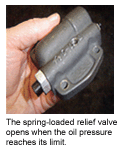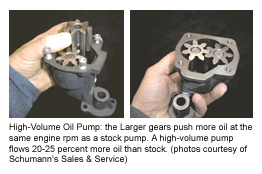 The oil pump is literally the heart of an engine’s lubrication system. It sucks oil in from the crankcase and pushes it through the filter and oil galleries to the crankshaft and camshaft bearings. A constant supply of oil is needed to support and cool the bearings. If for any reason the pump cannot keep the oil circulating, it’s the end of the road for the engine. So let’s see how well you know your oil pumps. Answer the following:
The oil pump is literally the heart of an engine’s lubrication system. It sucks oil in from the crankcase and pushes it through the filter and oil galleries to the crankshaft and camshaft bearings. A constant supply of oil is needed to support and cool the bearings. If for any reason the pump cannot keep the oil circulating, it’s the end of the road for the engine. So let’s see how well you know your oil pumps. Answer the following:
True or False – The oil pump creates oil pressure in the engine.
 If you answered “False,” you answered correctly. Now go treat yourself to a snack or a soda from the nearest vending machine – unless of course you can’t get a hall pass at this moment.
If you answered “False,” you answered correctly. Now go treat yourself to a snack or a soda from the nearest vending machine – unless of course you can’t get a hall pass at this moment.
The oil pump doesn’t actually create oil pressure. All the pump does is displace oil and push it into the oil galleys so it can flow to the bearings and upper valvetrain. What actually creates the oil pressure is the resistance the oil encounters as it circulates through the engine.
Most manufacturers recommend a minimum of 10 psi of oil pressure for every 1,000 rpm of engine speed. Using these numbers, most stock engines have about 50 to 60 psi of oil pressure. But some engines need more.
Let’s Talk Types
There are three basic types of oil pumps:
Twin gear pumps, also called “external” pumps, use a pair of intermeshing gears to pump oil. One gear is driven by a shaft and the second gear is driven by the first gear. The pump is usually driven by a shaft that connects to the crankshaft, camshaft or distributor shaft. Thus, the pump operates at half engine rpm. The pump gears turn in opposite directions. This traps oil between the gear teeth and carries it around the outside of each gear from the pickup tube inlet to the pump outlet. The tight clearances between the gears prevents the oil from flowing backwards to the inlet.
Rotor pumps, also called “gerotor” pumps, have an inner gear that turns inside an outer rotor. The inner gear has one less lobe than the outer rotor. The inner gear is also mounted slightly off center to the outer rotor, which forces the outer rotor to spin at about 80% of the speed of the inner gear. This creates a bellows-like pumping action that pulls oil from the inlet port and pushes it towards the outlet port. Close tolerances are required for good pumping efficiency. This type of pump may also be located in the crankcase.

Front cover pumps, also called “internal/external” pumps are usually located in the front engine cover. This is also a rotor-style pump with an inner drive gear and outer rotor, but the inner gear is mounted directly on the crankshaft. The direct drive approach eliminates the need for a separate pump drive shaft. This type of pump turns at the same rpm as the engine, so it generates more pressure at idle and does a better job of sucking oil from the crankcase and getting it to the upper valvetrain in a hurry. That’s why front cover pumps are used on many overhead cam engines. When this type of pump becomes worn, it is not always necessary to replace the entire cover assembly – provided the pump housing inside the cover is not worn or damaged. A new drive gear can be mounted on the crankshaft, and a new rotor can be installed in the cover to rejuvenate the pump.
Diagnosing Bad Pumps
With all three types of pumps, wear and damage are major concerns. Wear that increases internal clearances between the gears, rotor and housing will reduce the amount of oil the pump displaces and cause a drop in oil pressure and delivery volume. That’s why high-mileage oil pumps may need to be replaced.
Low oil pressure indicates trouble and may be caused by a low oil level, worn main and rod bearings or a worn oil pump. Low oil pressure can lead to bearing seizure and engine failure, so it should not be ignored. Sometimes a bad oil pressure sending unit will give a false alarm. But if oil pressure is really low and the crankcase is full, the engine may need bearings and/or a new oil pump.
Need More ‘Umpf From Your Pump?
For some applications, you might need a “high-volume” or a “high-pressure” oil pump. High-volume pumps typically have longer gear sets to displace more oil. A high-volume oil pump may flow 20% to 25% more oil than a stock pump to increase oil pressure at idle and to compensate for increased bearing clearances and wear in a high-mileage engine. But a high-volume oil pump is no cure-all for worn bearings or sloppy bearing clearances. A high-pressure oil pump, by comparison, uses a stiffer relief valve that does not open until a higher pressure is reached (75 psi or higher). This type of pump can provide additional oil pressure at high rpm, but won’t have any effect on idle pressure when the pump is turning slowly.



